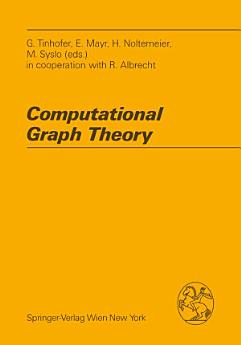Computational Graph Theory
Rudolf Albrecht · Gottfried Tinhofer · Ernst Mayr · Hartmut Noltemeier · Maciej M. Syslo
ডিচে ২০১২ · Computing Supplementa কিতাপ 7 · Springer Science & Business Media
ইবুক
282
পৃষ্ঠা
reportমূল্যাংকন আৰু পৰ্যালোচনা সত্যাপন কৰা হোৱা নাই অধিক জানক
এই ইবুকখনৰ বিষয়ে
One ofthe most important aspects in research fields where mathematics is "applied is the construction of a formal model of a real system. As for structural relations, graphs have turned out to provide the most appropriate tool for setting up the mathematical model. This is certainly one of the reasons for the rapid expansion in graph theory during the last decades. Furthermore, in recent years it also became clear that the two disciplines of graph theory and computer science have very much in common, and that each one has been capable of assisting significantly in the development of the other. On one hand, graph theorists have found that many of their problems can be solved by the use of com puting techniques, and on the other hand, computer scientists have realized that many of their concepts, with which they have to deal, may be conveniently expressed in the lan guage of graph theory, and that standard results in graph theory are often very relevant to the solution of problems concerning them. As a consequence, a tremendous number of publications has appeared, dealing with graphtheoretical problems from a computational point of view or treating computational problems using graph theoretical concepts.
এই ইবুকখনক মূল্যাংকন কৰক
আমাক আপোনাৰ মতামত জনাওক।
পঢ়াৰ নির্দেশাৱলী
স্মাৰ্টফ’ন আৰু টেবলেট
Android আৰু iPad/iPhoneৰ বাবে Google Play Books এপটো ইনষ্টল কৰক। ই স্বয়ংক্রিয়ভাৱে আপোনাৰ একাউণ্টৰ সৈতে ছিংক হয় আৰু আপুনি য'তে নাথাকক ত'তেই কোনো অডিঅ'বুক অনলাইন বা অফলাইনত শুনিবলৈ সুবিধা দিয়ে।
লেপটপ আৰু কম্পিউটাৰ
আপুনি কম্পিউটাৰৰ ৱেব ব্রাউজাৰ ব্যৱহাৰ কৰি Google Playত কিনা অডিঅ'বুকসমূহ শুনিব পাৰে।
ই-ৰীডাৰ আৰু অন্য ডিভাইচ
Kobo eReadersৰ দৰে ই-চিয়াঁহীৰ ডিভাইচসমূহত পঢ়িবলৈ, আপুনি এটা ফাইল ডাউনল’ড কৰি সেইটো আপোনাৰ ডিভাইচলৈ স্থানান্তৰণ কৰিব লাগিব। সমৰ্থিত ই-ৰিডাৰলৈ ফাইলটো কেনেকৈ স্থানান্তৰ কৰিব জানিবলৈ সহায় কেন্দ্ৰত থকা সবিশেষ নিৰ্দেশাৱলী চাওক।








